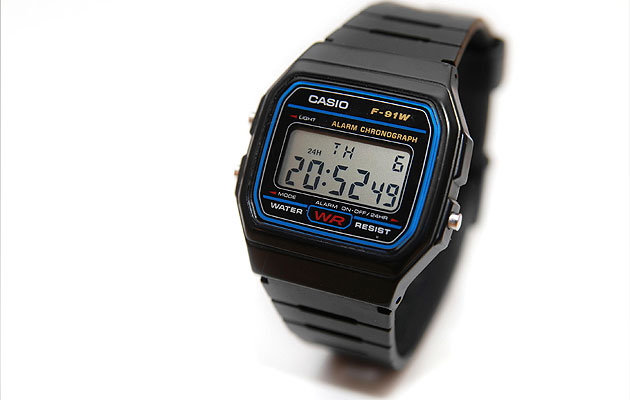|
|
||
|
Futuristic yet dated, the cheap and reliable Casio F-91W quartz digital watch is turning 20 years old this year. It may come as something of a surprise to learn that the F-91W is still so young; the black, plastic strap and distinctive blunted-rectangular face seems to have been around forever and its appearance speaks of the 1980s digi-tech revolution. While other digital watches have become obsolete, Casio still produces 3 million F-91Ws every year. Such sales figures are incredible considering the regularly proclaimed death of the watch. Yet the F-91W has often been accused of trying to destroy the whole watch industry and, after its appearance on the wrist of Osama bin Laden, even the Western world. The mobile phone currently takes the blame for falling watch sales but in the 80s it was the digital watch that was causing unrest among Swiss watchmakers. Cheap to make and requiring little technical skill, digital watches played a key part in manufacturers’ efforts to bring electronic goods to the masses. Casio was at the forefront of digital technology, introducing the plastic watchcase and strap in 1978. And once cheap digital watches became popular this meant that the watch itself was no longer a prestigious family heirloom which would last for generations; the watch was now cheap, mass-produced and had a lifespan of only a few years. The Casio watch was cast as the villain, a crime against watch design and a symbol of an unhealthy throwaway culture. But, like the mobile phone today, digital watches could offer their wearer more than just the time. In 1974 Casio had introduced the Casiotron, the world’s first digital watch with automatic calendar. Over the next decade they would add an ever-expanding list of extras – calculator, dictionary, phonebook, thermometer, altitude sensor, atmospheric sensor, compass and pulse-measuring device – to create ever more clunky plastic designs. The Casio watch was an item Swiss manufacturers would be forced to copy, but on their own terms. The current generation of luxury timepieces tend to feature an absurd array of dials and have become a male status symbol. It’s ironic then that it’s the Casio model that has proven the most timeless. In contrast to the current crop of Swiss watches, the F-91W seems positively restrained (the only functions are watch, calendar, timer and alarm). Its understated simplicity has won it a new generation of fans, not least among the young “creatives” of east London. For them its cheapness and robustness has become a pretentious sign of their self-perceived unpretentiousness. In Pakistan and Afghanistan, the F91-W has become another kind of symbol. Here, its cheapness and robustness have made it the terrorist’s choice for destruction. In 1995 Abdul Hakim Murad reportedly developed a technique to use the F-91W as a detonation device and militants trained by the late Osama bin Laden were supposedly taught how to wire the watch to explosives. In the videos bin Laden released to the world it is interesting to note that he himself wore one. It is the only branded item on display. The F-91W became so tainted by associations with terrorism that, in one of the Bush era’s more surreal decrees (revealed by recent WikiLeaks files), the Guantánamo Bay Combatant Status Review Tribunal reports gave mere ownership of the watch as sufficient reason for continued detainment. Defendants tried, unsuccessfully, to argue the absurdity of linking a watch with terrorism, pointing to the fact that many of the guards had similar watches. The F-91W has had a difficult life. Accused of everything from trying to destroy the watch industry to international terrorism, it is finally winning acclaim for everything it was initially accused of not being. It’s celebrated for its durability and longevity, which compare favourably to the engineered obsolescence of current digital products. And even the watch’s “ugly” 1980s design has ensured its late flourishing as a retro classic.
Osama Bin Laden |
Words Duncan Marsden |
|
|
||




















